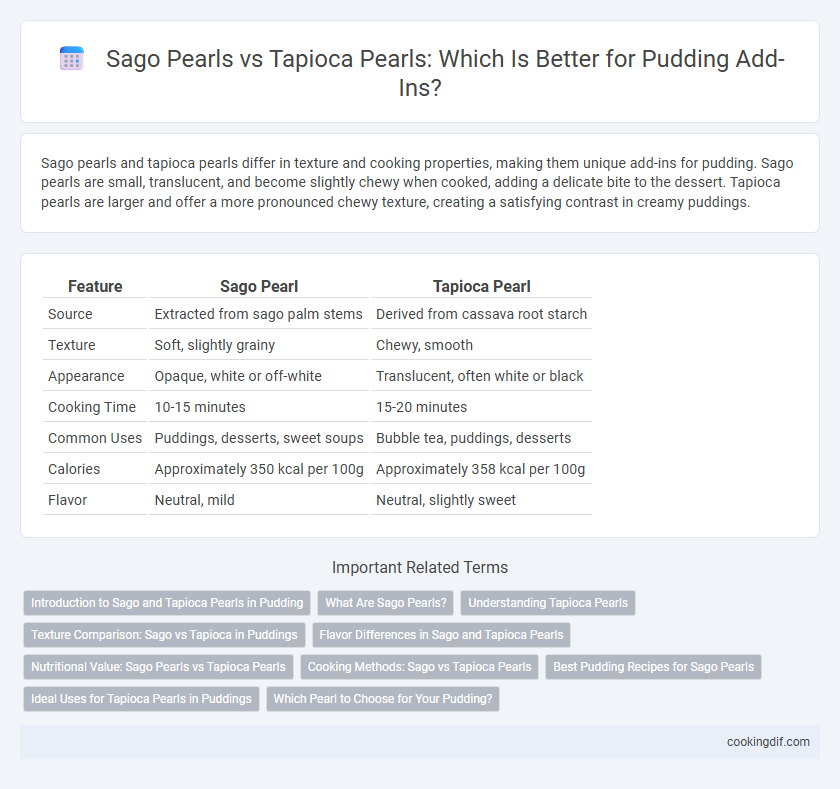Sago pearls and tapioca pearls differ in texture and cooking properties, making them unique add-ins for pudding. Sago pearls are small, translucent, and become slightly chewy when cooked, adding a delicate bite to the dessert. Tapioca pearls are larger and offer a more pronounced chewy texture, creating a satisfying contrast in creamy puddings.
Table of Comparison
| Feature | Sago Pearl | Tapioca Pearl |
|---|---|---|
| Source | Extracted from sago palm stems | Derived from cassava root starch |
| Texture | Soft, slightly grainy | Chewy, smooth |
| Appearance | Opaque, white or off-white | Translucent, often white or black |
| Cooking Time | 10-15 minutes | 15-20 minutes |
| Common Uses | Puddings, desserts, sweet soups | Bubble tea, puddings, desserts |
| Calories | Approximately 350 kcal per 100g | Approximately 358 kcal per 100g |
| Flavor | Neutral, mild | Neutral, slightly sweet |
Introduction to Sago and Tapioca Pearls in Pudding
Sago pearls are small, starchy balls derived from the pith of tropical palm stems, often used in traditional Asian puddings for their chewy texture. Tapioca pearls, extracted from the cassava root, provide a similar but slightly firmer bite and are widely popular in bubble teas and Western-style puddings. Both add unique textures and mild flavors, enhancing the sensory experience of pudding desserts through their gelatinous consistency and ability to absorb surrounding flavors.
What Are Sago Pearls?
Sago pearls are small, translucent spheres made from the starch extracted from the pith of tropical palm stems, primarily the sago palm. These pearls have a slightly gelatinous texture when cooked and are commonly used in desserts and puddings for their unique chewiness and ability to absorb flavors. Unlike tapioca pearls, which derive from cassava root starch, sago pearls offer a distinct neutral taste and a different cooking process that requires thorough boiling to achieve the desired consistency.
Understanding Tapioca Pearls
Tapioca pearls, derived from the cassava root, offer a chewy texture and neutral flavor, making them a versatile addition to various pudding recipes. Unlike sago pearls, tapioca pearls are slightly larger and become translucent when cooked, enhancing the pudding's visual appeal and mouthfeel. Their gluten-free nature and ability to absorb surrounding flavors make tapioca pearls a popular choice for creating creamy, rich desserts.
Texture Comparison: Sago vs Tapioca in Puddings
Sago pearls provide a slightly firmer, chewier texture in puddings compared to the smooth, gelatinous consistency of tapioca pearls, which tend to be softer and more translucent. Tapioca pearls absorb flavors more readily, enhancing the pudding's taste profile while sago pearls offer a more distinct bite that maintains structural integrity longer. Both add visually appealing texture, but pudding recipes aiming for a delicate, melt-in-mouth experience favor tapioca pearls over sago.
Flavor Differences in Sago and Tapioca Pearls
Sago pearls offer a subtle, mildly nutty flavor that blends seamlessly into puddings without overpowering the dessert's primary taste, while tapioca pearls provide a neutral, slightly sweet flavor that enhances the overall creaminess. The texture differences influence perception: sago pearls are smaller and softer, allowing their gentle flavor to complement delicate puddings, whereas tapioca pearls are larger and chewier, often contributing a more distinct mouthfeel. Flavor nuances of sago pearls suit traditional Southeast Asian puddings, whereas tapioca pearls are preferred in Western-style desserts for their sweet, pliable character.
Nutritional Value: Sago Pearls vs Tapioca Pearls
Sago pearls and tapioca pearls differ in nutritional value, with sago pearls containing slightly higher carbohydrates and calories per serving compared to tapioca pearls. Tapioca pearls provide minimal protein and fat but are a good source of quick energy due to their high starch content. Both add-ins are low in fiber and micronutrients, making them primarily energy-dense ingredients in pudding recipes.
Cooking Methods: Sago vs Tapioca Pearls
Sago pearls require longer soaking and careful simmering to achieve a translucent, jelly-like texture, often taking 15 to 30 minutes to cook thoroughly. Tapioca pearls cook faster, typically boiling for 10 to 15 minutes until they become soft and chewy, with a slightly more robust bite compared to sago. Proper straining and rinsing are essential for both to remove excess starch and prevent clumping, impacting the final pudding's smoothness.
Best Pudding Recipes for Sago Pearls
Sago pearls and tapioca pearls differ in texture and origin, with sago pearls made from the pith of the sago palm and tapioca pearls derived from cassava starch. Sago pearls create a more translucent and slightly firmer pudding texture, making them ideal for traditional Southeast Asian dessert recipes that emphasize a chewy yet soft consistency. For the best pudding recipes featuring sago pearls, incorporate coconut milk and palm sugar to enhance their natural subtle flavor, resulting in a rich, creamy, and authentically textured dessert.
Ideal Uses for Tapioca Pearls in Puddings
Tapioca pearls offer a chewy texture and translucent appearance that enhances the visual appeal and mouthfeel of puddings, making them ideal for creamy desserts like coconut or vanilla-based puddings. Their ability to absorb flavors while maintaining firmness ensures a balanced contrast with smooth, sweet pudding bases. Tapioca pearls are preferred over sago pearls for pudding add-ins due to their consistent size and smoother, gelatinous consistency that complements diverse flavor profiles.
Which Pearl to Choose for Your Pudding?
Sago pearls, derived from the pith of tropical palm stems, offer a translucent, slightly chewy texture ideal for traditional pudding recipes, while tapioca pearls, made from cassava starch, provide a more consistent, bouncy bite favored in bubble teas and desserts. For a smooth, gelatinous pudding consistency, tapioca pearls are preferred due to their ability to absorb flavors and maintain shape during cooking. Choosing between sago and tapioca pearls depends on desired texture and flavor absorption, with tapioca pearls generally providing a more versatile option for creamy, rich puddings.
Sago pearl vs Tapioca pearl for add-ins Infographic

 cookingdif.com
cookingdif.com